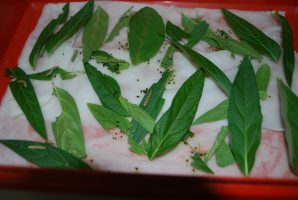Blog by Susan Burk
Member, Wild Ones – St. Louis Chapter
[Editor’s Note: At the end of the gathering on Wednesday, April 12, 2017, Fred and Susan Burk were busy counting monarch eggs. They need our help as these early monarch eggs are now hungry caterpillars!]
It is unusual to have monarchs visit the St. Louis area in the spring. We normally see them as they are migrating south in late summer. This year, possibly because of storms in Texas and Oklahoma, they were “pushed” north and east. Problem with the early arrivals is that our milkweed has not started growing yet and there is not enough milkweed to feed the cat’s.
Female monarchs visited my yard on April 9, and because there were more than a hundred butterfly and marsh milkweed potted plants in my backyard, they had a great time laying eggs, which started hatching on April 16 and 17.
So far we have collected more than one hundred tiny caterpillars!
We are looking for some help to raise these baby monarchs. It is fun and really easy. All you need is a container, milkweed plants, and a little time. We collected the caterpillars to ensure they had enough milkweed available as they grew and to protect them from predators.
Tips and Guidelines:
**We use plastic containers with lids, lined with moist paper towels (to help keep the leaves fresh) and milkweed leaves.
**They need fresh leaves every day or two and their container cleaned of frass (poo) as needed.
**They prefer young and tender leaves especially when they are still tiny.
**They will molt four times with the final one as they begin to make the chrysalis.
**When they are shedding their skin or molting, they can be very still, (sometimes for 24 hours) maybe on the side of your container. They should not be disturbed.
**When the caterpillar gets larger, we put them in an aquarium with a screen top, or a critter cage would work. Just pick up the leaves with caterpillars and move them.
**We keep paper towels in the bottom for ease of cleaning and a stick or two for climbing.
**A small glass with milkweed stems in water is a good way to feed your growing family.
When 10 to 14 days old, they will crawl to the top of the container to pupate. They spin a silk button and hang upside down in a J shape for about 14 hours. They unzip their skin and do a “pupa dance” turning into a beautiful jade color with gold trim.
The chrysalis will start turning a dark color after one or two weeks and the monarchs will emerge usually first thing in the morning. It will take several hours for the wings to harden. When they start to flutter their wings they are ready to be released. Very exciting!!
A good reference book is How to Raise Monarch Butterflies: A step-by-Step Guide for Kids by Carol Pasternak. We bought our copy on Amazon. [Reminder: If you shop at smile.amazon.com, and choose Wild Ones as your charity of choice, Amazon donates 0.5% of the price of your eligible purchases to our organization.]
We would love to share these
remarkable and
beautiful
caterpillars
so you can experience the Monarch Miracle!
If you want to and are able to help, please email us at fred.burk@att.net or call our home phone at 314-821-6072.






I have an abundance of milkweed coming up and would be willing to share and also to become a foster parent to the homelessl Mary Joe came by this a.m. and took some for her brood.
Al;ice
314-644-6606
Drat! Have no milkweed but just planted remaining yard with all native plants/pollinator. Next year should be great!
Same situation. Just planted milkweed this year. More than happy to help next year.
I don’t have milkweed but if someone has extra milkweed leaves, I would love to raise some monarchs with my students.
I can brimg some common milkweed cuttings. Would that help? When would you like them.
I have hundreds of my brood in the yard. Will let them thrive on what’s available (hopefully enough!). They seem to grow slowly (as compare to what described in the books). Will keep photographing them on each stage.
Second attempt at posting. I can provide you with common milkweed cuttings. Can you use them? When would you like them?
I would love some common milkweed cuttings anytime. Some are getting very large and hungry. Thanks, Susan
I have found that cats raised on one kind of milkweed do not thrive if given another kind. Ex. Swamp to common it killed some
Hi, Susan, 1st report on the six Monarch Cats you so kindly let me care for. They are all fine and one has started it’s chrysalis state. 3 more are getting real big, the other two are growing. Thanks Cathy Gunter